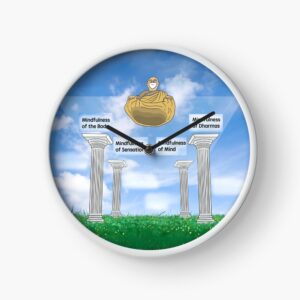
(Context: Definitive definition of mindfulness)
The Buddha’s discourse on the establishment of mindfulness was recorded mainly in the Discourse on the Establishment of Mindfulness.[1] It’s worth noting that entire books and PhD theses have been written on this one really important discourse.
To successfully establish right mindfulness, one needs these three other mental qualities besides mindfulness:
- ardency
- clear comprehension
- putting away “covetousness and grief for the world”.[2]
To be ardent is simply to be resolute and diligent in practicing right effort. Mahā Kassapa, one of the Buddha’s top disciples, says: “A monk arouses ardor by thinking: ‘If unarisen evil unwholesome states arise in me, or if wholesome states that have arisen in me cease, this may lead to my harm.’ Thus he is ardent.”[3]
The Buddha once gave a very useful definition of clear comprehension as: “seeing and understanding the arising, presence, and passing away of sensations, thoughts and perceptions.”[4] However, clear comprehension also more broadly means “the type of awareness that develops wisdom“. Four Buddhist teachers I respect refer to it operationally as “full awareness” (Bhikkhu Ñāṇamoli)[5], “situational awareness” (Bhikkhu Sujato)[6], and “introspective awareness” (Dalai Lama and Thubten Chodron)[7].
Clear comprehension can also be thought of as the wise discernment aspect of mindfulness. Mindfulness and clear comprehension are practiced together as a pair. You may find that Buddhist teachers do not necessarily agree on where the exact boundary lies between mindfulness and clear comprehension, and there are even teachers who totally disregard the boundary and teach mindfulness + clear comprehension as a single thing. That is all fine, since both qualities are practiced in tandem anyway, and Buddhist teachers care far more about practice than theory.
The mental quality of “putting away covetousness and grief for the world” refers to a meaningful depth of samadhi that leads to the temporary abandoning of the five hindrances (which we will discuss in detail in a later article).[8] Here, you catch a glimpse of the close, mutually-reinforcing relationship between right samadhi and right mindfulness: the stronger your practice of right samadhi, the more successfully you can practice right mindfulness, and vice versa.
These three mental qualities do not necessarily have to be present before you practice the establishment of mindfulness, because they grow as a consequence of the practice. In that sense, they form a virtuous cycle with the establishment of mindfulness.
The Four Establishments of Mindfulness
Like a chair constructed upon four legs, mindfulness is built upon four establishments, which are:
- Mindfulness of the body
- Mindfulness of sensations
- Mindfulness of mind
- Mindfulness of dharmas
Well, technically, that was not how the Buddha named them. He actually named the four establishments as the anupassanā-ing of (not “mindfulness of”) body, sensations, mind and dharmas. Remember (from this post) that anupassanā means close and repeated observation, often translated inadequately as contemplation. However, many respected modern Buddhist teachers teach them as “mindfulness of [object]”[9], which is also not incorrect, since the Buddha included the other key components of mindfulness in the actual instructions, namely presence (upaṭṭhāna) and fully knowing (pajānāti). We decided to follow that popular modern convention, partly out of convenience, and partly to avoid causing confusion.
We will examine each establishment of mindfulness in detail in the next four articles.
Activities
References
[1] Satipaṭṭhāna Sutta (Majjhima Nikāya 10). It is also recorded in the Great Discourse on the Establishment of Mindfulness (Mahasatipaṭṭhāna Sutta, Dīgha Nikāya 22). The “great” edition is identical to the standard edition, except the Buddha talked a bit more about the Four Noble Truths.
[2] In Pali: ātāpī, sampajañña, and vineyya abhijjhādomanassa, respectively.
[3] Saṃyutta Nikāya 16.2.
[4] Saṃyutta Nikāya 47.35.
[5] In Bhikkhu Ñāṇamoli’s translation of Majjhima Nikāya 10.
[6] In Bhikkhu Sujato’s translation of Majjhima Nikāya 10.
[7] Dalai Lama and Thubten Chodron, Following in the Buddha’s Footsteps. Wisdom Publications (2019).
[8] Ajahn Brahm makes this same point in Mindfulness, Bliss and Beyond. Wisdom Publications (2006).
[9] For example, Bhante Gunaratana in Mindfulness in Plain English. Wisdom Publications (2011).
Featured image by Colin Goh.
Sharing Joy and Wisdom with our Buddhist Art
Our team is honored to work with talented artists to create meaningful Buddhist art. To share these creations more widely, we are offering them on thoughtfully crafted merchandise. We hope these items can serve as gentle reminders and companions to inspire wisdom, compassion, and joy in daily life. [Learn More].
Explore our entire Buddhism.net collection here.
Explore the Four Pillars of Mindfulness design collection here.






Merchandise highlights from this design collection


